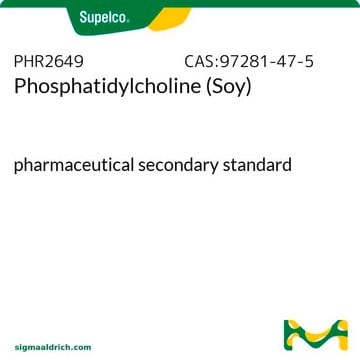SMB00611
1,2-Dilauroyl-sn-glycero-3-phosphorylglycerol sodium salt
≥98%
Sinónimos:
1,2-Didodecanoyl-sn-glycero-3-phosphorylglycerol sodium, 1-[[[(2,3-Dihydroxypropoxy)hydroxyphosphinyl]oxy]methyl]-1,2-ethanediyl ester-dodecanoic acid sodium
About This Item
Productos recomendados
Ensayo
≥98%
Formulario
powder
grupo funcional
carboxylic acid
tipo de lípido
phosphoglycerides
Condiciones de envío
wet ice
temp. de almacenamiento
−20°C
InChI
1S/C30H59O10P.Na/c1-3-5-7-9-11-13-15-17-19-21-29(33)37-25-28(26-39-41(35,36)38-24-27(32)23-31)40-30(34)22-20-18-16-14-12-10-8-6-4-2;/h27-28,31-32H,3-26H2,1-2H3,(H,35,36);/q;+1/p-1/t27-,28+;/m0./s1
Clave InChI
CIRSYGHBBDDURM-DUZWKJOOSA-M
Acciones bioquímicas o fisiológicas
Phosphatidylglycerols are used in in silico studies of model membranes. Under specific experimental conditions, they exhibit similar phase transition properties as zwitterionic phosphatidylcholines[2]. Lipid-based particle drug delivery studies using dispersions of dilauroylphosphatidylethanolamine (DLPE) and dilauroylphosphatidylglycerol (DLPG) have been shown to exhibit a metastable state which allows for the manipulation of delayed nucleation; thus providing new avenues in the design of novel modalities for the drug delivery of therapeutic payloads[3].
Código de clase de almacenamiento
11 - Combustible Solids
Clase de riesgo para el agua (WGK)
WGK 3
Punto de inflamabilidad (°F)
Not applicable
Punto de inflamabilidad (°C)
Not applicable
Elija entre una de las versiones más recientes:
Certificados de análisis (COA)
¿No ve la versión correcta?
Si necesita una versión concreta, puede buscar un certificado específico por el número de lote.
¿Ya tiene este producto?
Encuentre la documentación para los productos que ha comprado recientemente en la Biblioteca de documentos.
Active Filters
Nuestro equipo de científicos tiene experiencia en todas las áreas de investigación: Ciencias de la vida, Ciencia de los materiales, Síntesis química, Cromatografía, Analítica y muchas otras.
Póngase en contacto con el Servicio técnico








